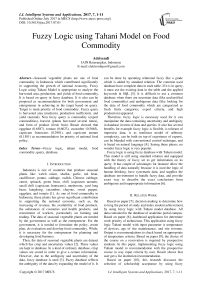Fuzzy Logic using Tahani Model on Food Commodity
Автор: Adriyendi
Журнал: International Journal of Intelligent Systems and Applications(IJISA) @ijisa
Статья в выпуске: 7 vol.9, 2017 года.
Бесплатный доступ
Seasonal vegetable plants are one of food commodity in Indonesia which contributed significantly in supporting the growth of national economy. Fuzzy Logic using Tahani Model is appropriate to analyze the harvested area, production, and yields of food commodity. It is based on query in fuzzy database. It is also can be proposed as recommendation for both government and entrepreneur in achieving in the target based on query. Target is main priority of food commodity. Fuzzy query is harvested area (medium), production (sufficient), and yield (normal). Non fuzzy query is commodity (export commodities), harvest (plants harvested several times), and form of product (fresh fruit). Result showed that eggplant (0.6587), tomato (0.6023), cucumber (0.5865), capsicum frutescens (0.2901), and capsicum annum (0.1581) as recommendation for priority of national food policy.
Fuzzy logic, tahani model, food commodity, query, database
Короткий адрес: https://sciup.org/15010944
IDR: 15010944
Текст научной статьи Fuzzy Logic using Tahani Model on Food Commodity
Published Online July 2017 in MECS DOI: 10.5815/ijisa.2017.07.01
Indonesia is one of countries that produce seasonal plants like: welch onion, shallot, garlic, red bean, cauliflower, potato, cabbage, radish, Chinese cabbage, carrot, spinach, green bean, chili (capsicum annum), small chili (capsicum frutescens), mushroom, yard long bean, kangkong, cucumber, chayote, sweet pepper, eggplant, and tomato [1]. As one of food commodity in Indonesia, these plants has given significant contribution in supporting the national economy, such as, the increasing of revenue, the availability of food products, the substances of cosmetics and health products, and recruitment of workers, particularly on farming and trading. The data of seasonal vegetable plants are needed by the government as well as the entrepreneur. For the government, it is needed to formulate the policy, create plan, do evaluation and develop food commodity. While, it is necessary for the entrepreneur for planning and developing food business.
Then, the data of seasonal vegetable plants are dataset which has crisp and uncertainty values [2]. These values are kept in database. In a kind of ordinary database, crisp values are stored in order to give a certain information. However, due to the ambiguity and uncertainty of the data, fuzzy database is used [3]. Fuzzy database reflects the ambiguity of the data by expanding the model of it. It can be done by operating relational fuzzy like a grade which is added by standard relation. The common used database have complete data in each table. If it is in query, it must use the existing data in the table and the applied keywords in SQL [5]. It is difficult to use a common database when there are uncertain data (like unclassified food commodity) and ambiguous data (like looking for the data of food commodity which are categorized as fresh fruits categories, export criteria, and high production) appeared.
Therefore, fuzzy logic is necessary used for it can manipulate the data containing uncertainty and ambiguity in database in term of data and queries. It also has several benefits for example fuzzy logic is flexible, is tolerant of imprecise data, is as nonlinear model of arbitrary complexity, can be built on top of experience of experts, can be blended with conventional control technique, and is based on natural language [4]. Seeing these pluses, no wonder fuzzy logic is very popular.
Fuzzy logic is using fuzzy database with Tahani model. This model is still using standard relation and equipped with the theory of fuzzy set to get information on its query. It has couple of advantages for instance allow the handling of data naturally because it is used the logic of human thinking, have systematic data, and supplies the database environment to handle fuzzy data, and provide exact way to describe the exact conclusions from ambiguous and inappropriate information [6].
-
II. Related Work
Based on paper [7], decision making to determine how to long the period of study and index student achievement, by using fuzzy logic with Tahani model database. All data contained in the database of academic portal campus. Based on paper [8], dashboard application for determine work priority of technicians. This application using fuzzy logic Tahani model with input parameter is temperature of devices, age of site maintenance, and site revenue. Output is recommendations to check based on appropriate of temperature criteria. Based on paper [9], the choice of the course on a reservation is required by prospective students. In this paper, implementing fuzzy logic using Tahani model to recommendation with the prospective course in way input criteria by user. Result shown that user get a list institution recommendation.
Based on paper [10], this research discusses the selection of scholarship acceptance by using fuzzy database Tahani and Simple Additive Weighting to determine recipients. The results showed that ranking user and recommendation to the receiving scholarships. Based on paper [11], implementing fuzzy Tahani model of database with Max-Min rules to choice of motorcycle. A fuzzy set model with 3 criteria: condition, year of manufacture, prices. Results shown that fuzzy Tahani model of database with Max-Min can give recommendation for the buyers.
-
III. Method Proposed
Method proposed is implementing Fuzzy Logic using Tahani Model. Process of Fuzzy Logic is Fuzzy-fication, Inference, and Defuzzy-fication. Tahani Model based on Query (Fuzzy Query and Non Fuzzy Query).
-
A. Framework
Method proposed can be depictured with Framework, shown in Fig. 1.

B. Variable Fuzzy Criteria: Harvested Area Sub-Criteria: (Small, Medium, Big)

Criteria: Production Sub-Criteria: (Few, Sufficient, Excessive)
C. Input Membership Function

D. Fuzzyfication
Criteria: Yield Sub-Criteria: (Minimum, Normal, Maximum)
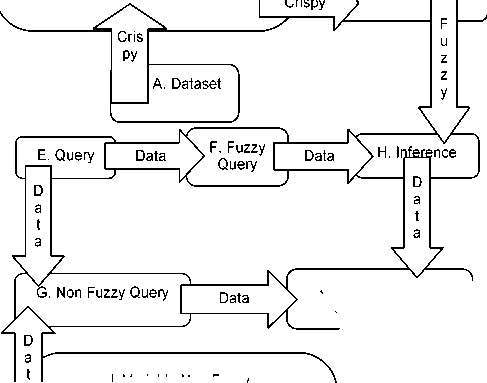
J. Defuzzy-fication (Fire Strength)
а
Ч— Sub-Criteria: (Export, Non Export)
I. Variable Non Fuzzy Criteria: Commodity
Criteria: Harvest
Sub-Criteria: (Plants Harvested Entirely, Plants Harvested Several Times)
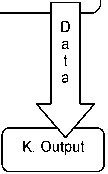
Criteria: Form of Product Sub-Criteria: (Fresh Leaf, Fresh Fruit, Fresh Pod, Fresh Roots with Leaf)

Fig.1. Framework
Fig. 1 shown step by step process in Framework. Step A; Dataset based data source. Step B: Variable Fuzzy based on expert input. Step C: Input Membership Function based on fuzzy truth-value and Membership Degree. Step D: Fuzzy-fication based on Fuzzy Logic. Step E: Query based on expert input. Query consist of Fuzzy Query on Step F and Non Fuzzy Query on Step G. Step H: Inference by rules as fuzzy input and output variables (variable fuzzy and variable non fuzzy). Step I: Variable Non Fuzzy based on expert input. Step J: Defuzzy-fication based on Fire Strength minimum. Step K: Output based on Fire Strength with interval 0 and 1.
Crispy changed became data based on Dataset in step by step of Framework. Output is recommendation as main priority.
-
B. Fuzzy Logic
Fuzzy Logic is the method for mapping space input to space output. Fuzzy logic used to data processing in decision making. Fuzzy Logic Fuzzy apply to decision making and give recommendation. Fuzzy Logic display on Fig. 2.
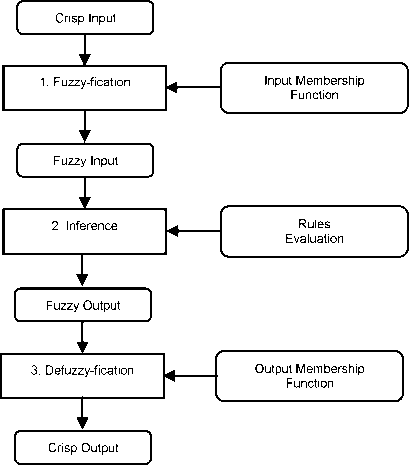
Fig.2. Fuzzy Logic
There are 3 steps in this method [12]. Step 1: Fuzzy-fication is process mapping the input into fuzzy query by input membership function. Steps 2: Inference by rules as evaluation to get output. Step 3: Defuzzy-fication is process converting into crisp output. Output depend on fuzzy set, variable fuzzy and variable non fuzzy [13]. The fuzzy truth-value is interval [0 and 1] on fuzzy set. Representation value 0 is completely false and 1 is completely true. In linguistic terms, the truth-values are expressed of sentence “x” will be denoted as μ(x). In any condition, fuzzy set like: small area, excessive production, maximum yield, where the condition can be given a value between 0 and 1. Fuzzy set [14] allow operations of union (fuzzy union = fuzzy OR), intersection (fuzzy intersection = fuzzy AND), and complement (fuzzy complement = fuzzy NOT). For this application are using fuzzy intersection. Standard fuzzy operations based on paper [13]:
A = цА (x) / x : x e X, цА (x)e[0,1]
If(XlisAli • X2isA2i •...• XmisAmiWnyi = k
(A^Bxx> min 12A(x),B(x)2|
Symbol • noted as operator AND, where k is a constant, and A is fuzzy set, x element with interval [0, 1]. Fuzzy set based on equation (1). Fuzzy intersection based on equation (2). Defuzzy-fication based on Fire Strength minimum using equation (3).
-
C. Tahani Model
-
• Memberships Function for each criteria or variable fuzzy. Membership Function depictured by a curve shown that mapping point data input to membership value with interval 0 and 1. Membership Function using linier curve.
-
• Fuzzy-fication as calculation fuzzy with value change from crispy to fuzzy. Each variable fuzzy calculate value membership cardinality for each fuzzy set.
-
• Query on Fuzzy-fication assumption as conventional query (non fuzzy) with formed query with standard relation. Operator used to standard relation is intersection.
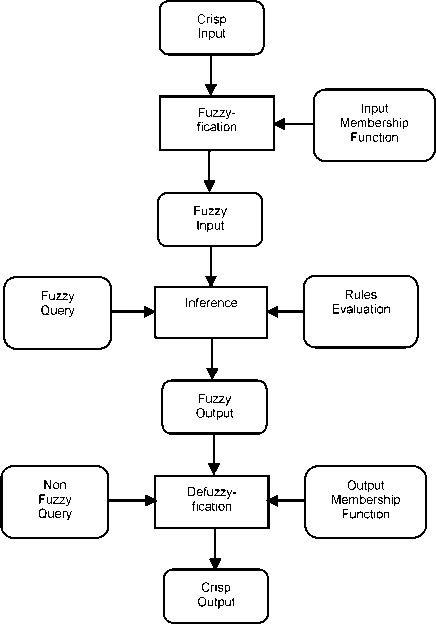
Fig.3. Tahani Model
Fig. 3 shown Tahani Model using Fuzzy Query and Non Fuzzy Query. Fuzzy Query used to process of inference. Non Fuzzy Query used to process of defuzzy-fication.
-
IV. Result and Discussion
Fuzzy Logic using Tahani Model on Food Commodity based on Dataset from data source (Statistics of Seasonal Vegetable and Fruit Plants, BPS-Statistic Indonesia 2015). Process of Dataset by using Excel software.
-
A. Dataset
Dataset can be seen on Table 1.
Table 1. Dataset
|
No. |
Food Commodity |
Harvested Area (Ha) |
Production (Ton) |
Yield (Ton/Ha) |
|
1 |
Welch Onion |
52.895 |
512.497 |
9.69 |
|
2 |
Shallot |
122.126 |
1.229.189 |
10.06 |
|
3 |
Garlic |
2.563 |
20.293 |
7.92 |
|
4 |
Red Bean |
15.637 |
42.388 |
2.71 |
|
5 |
Cauliflower |
11.195 |
118.394 |
10.58 |
|
6 |
Potato |
66.983 |
1.219.277 |
18.20 |
|
7 |
Cabbage |
64.625 |
1.443.227 |
22.33 |
|
8 |
Radish |
1.427 |
21.479 |
15.05 |
|
9 |
Chinese Cabbage |
58.652 |
600.200 |
10.23 |
|
10 |
Carrot |
30.280 |
522.529 |
17.26 |
|
11 |
Spinach |
42.138 |
150.093 |
3.56 |
|
12 |
Green Bean |
25.645 |
291.333 |
11.36 |
|
13 |
Capsicum |
120.847 |
1.045.200 |
8.65 |
|
Annum |
||||
|
14 |
Capsicum Frutescens |
134.869 |
869.954 |
6.45 |
|
15 |
Mushroom |
536 |
33.485 |
62.53 |
|
16 |
Yard Long Bean |
63.177 |
395.524 |
6.26 |
|
17 |
Kangkong |
48.996 |
305.080 |
6.23 |
|
18 |
Cucumber |
43.573 |
447.696 |
10.27 |
|
19 |
Chayote |
9.436 |
431.219 |
45.70 |
|
20 |
Sweet Pepper |
183 |
5.658 |
30.92 |
|
21 |
Eggplant |
45.919 |
514.332 |
11.20 |
|
22 |
Tomato |
54.544 |
877.801 |
16.09 |
|
Total |
1.016.246 |
11.096.848 |
343.25 |
|
|
Maximum |
134.869 |
1.443.227 |
62.53 |
|
|
Minimum |
183 |
5.658 |
2.71 |
|
|
Average |
46.193 |
504.402 |
15.60 |
|
Table 1 shown dataset with variable total, maximum minimum, and average to determine membership function.
-
B. Variable Fuzzy
Variable Fuzzy can be seen on Table 2.
Table 2. Variable Fuzzy
|
No. |
Criteria |
Variable Fuzzy |
||
|
1 |
Harvested Area |
Small |
Medium |
Big |
|
2 |
Production |
Few |
Sufficient |
Excessive |
|
3 |
Yield |
Minimum |
Normal |
Maximum |
-
C. Membership Function
Membership Function showed on Table 3.
Table 3. Membership Function
|
Small |
|||
|
<=183 |
183<=x<=46.193 |
>=46.193 |
|
|
1 |
(46.193-x)/ (46.193-183) |
0 |
|
|
Medium |
|||
|
<=46.193 |
183<=x <=46.193 |
46.193<=x <=134.869 |
>=134.869 |
|
0 |
(x-183)/ (46.193-183) |
(134.869x)/ (134.869-46.193) |
0 |
|
Big |
|||
|
<=46.193 |
46.193<=x<=134.869 |
>=134.869 |
|
|
0 |
(x-46.193)/(134.869-46.193) |
1 |
|
|
Few |
|||
|
<=5.658 |
5.658<=x <=504.402 |
>=504.402 |
|
|
1 |
(504.402-x)/ (504.402-5.658) |
0 |
|
|
Sufficient |
|||
|
<=5.658 |
5.658<=x <=504.402 |
504,402<=x <=1.443.227 |
>=1.443.227 |
|
0 |
(x-5.658)/ (504.4025.658) |
(1.443.227x)/ (1.443.227504.402) |
0 |
|
Excessive |
|||
|
<=504.402 |
504.401<=x <=1.443.227 |
>=1.443.227 |
|
|
0 |
(x-504.402)/ (1.443.227-504.402) |
1 |
|
|
Minimum |
|||
|
<=2.71 |
2.71<=x<=15.60 |
>=15.60 |
|
|
1 |
(15.60-x)/(15.60-2.71) |
0 |
|
|
Normal |
|||
|
<=15.60 |
15.60<=x<=62.53 |
15.60<=x<=62.53 |
>=62.53 |
|
0 |
(x-15.60)/(62.53-15.60) |
(62.53-x)/(62.53-15.60) |
0 |
|
Maximum |
|||
|
<=15.60 |
15.60<=x<=62.53 |
>=62.53 |
|
|
0 |
(x-15.60)/(62.53-15.60) |
1 |
|
Table 3 shown Membership Function with Membership Degree for each variable.
Variable Small with bottom boundary is x<=183, middle boundary is 183<=x<=46.19, top boundary is >=46.193, and interval [1, 0]. Variable Medium with bottom boundary is x<=46.193, middle boundary is 183<=x<=46.193 and 46.193<=x<=134.869, top boundary is x>=134.869, and interval [0, 0]. Variable Big with bottom boundary is x<=46.193, middle boundary is 46.193<=x<=134.869, top boundary is x>=134.869, and interval [0, 1]). Membership degree and interval to variable Few, Sufficient, Excessive Minimum, Normal, and Maximum display on Table 3. Fig. 4 shown curve triangular based on Membership Function.

|
46. |
134. |
||
|
193 |
183 |
869 |
46.193 |
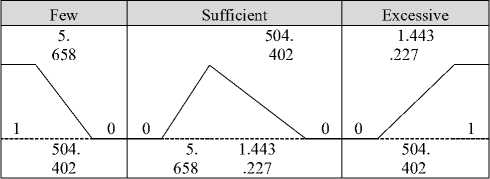
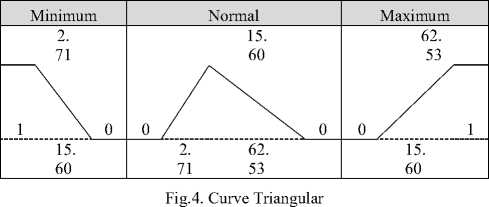
Table 4. Fuzzy-fication 1
|
Harvested Area |
Production |
||||
|
183 |
46,193 |
134,869 |
5,658 |
504,402 |
1,443,227 |
|
Small |
Medium |
Big |
Few |
Sufficient |
Excessive |
|
0 |
0.9244 |
0.0756 |
0 |
0.9914 |
0.0086 |
|
0 |
0.1437 |
0.8563 |
0 |
0.2280 |
0.7720 |
|
0.9483 |
0.0517 |
0 |
0.9707 |
0.0293 |
0 |
|
0.6641 |
0.3359 |
0 |
0.9264 |
0.0736 |
0 |
|
0.7607 |
0.2393 |
0 |
0.7740 |
0.2260 |
0 |
|
0 |
0.7656 |
0.2344 |
0 |
0.2385 |
0.7615 |
|
0 |
0.7921 |
0.2079 |
0 |
0 |
1 |
|
0.9730 |
0.0270 |
0 |
0.9683 |
0.0317 |
0 |
|
0 |
0.8595 |
0.1405 |
0 |
0.8980 |
0.1020 |
|
0.3459 |
0.6541 |
0 |
0 |
0.9807 |
0.0193 |
|
0.0881 |
0.9119 |
0 |
0.7104 |
0.2896 |
0 |
|
0.4466 |
0.5534 |
0 |
0.4272 |
0.5728 |
0 |
|
0 |
0.1581 |
0.8419 |
0 |
0.4240 |
0.5760 |
|
0 |
0 |
1.0000 |
0 |
0.6106 |
0.3894 |
|
0.9923 |
0.0077 |
0 |
0.9442 |
0.0558 |
0 |
|
0 |
0.8085 |
0.1915 |
0.2183 |
0.7817 |
0 |
|
0 |
0.9684 |
0.0316 |
0.3996 |
0.6004 |
0 |
|
0.0569 |
0.9431 |
0 |
0.1137 |
0.8863 |
0 |
|
0.7989 |
0.2011 |
0 |
0.1467 |
0.8533 |
0 |
|
1 |
0 |
0 |
1 |
0 |
0 |
|
0.0060 |
0.9940 |
0 |
0 |
0.9894 |
0.0106 |
|
0 |
0.9058 |
0.0942 |
0 |
0.6023 |
0.3977 |
-
D. Fuzzy-fication
Fuzzy-fication display on Table 4.
Table 4 shown result of fuzzy-fication using variable: Small, Medium, Big, Few, Sufficient, and Excessive.
Table 4 shown fuzzy-fication using Excel with formula:
This formula for criteria (Harvested Area) and variable (Small) by operator intersection = AND, and interval fuzzy [0, 1]. Fuzzy-fication based on equation (1) and equation (2).
Table 5 shown result of fuzzy-fication using variable: Minimum, Normal, and Maximum on Criteria Yield.
= IF(F24<=I$23,1,
IF(AND(F24>=I$23,F24<=J$23),(J$23-F24)/(J$23-I$23), IF(F24>=J$23,0,0)))
Table 5. Fuzzy-fication 2
|
Yield |
Yield |
||||
|
2.71 |
15.60 |
62.53 |
2.71 |
15.60 |
62.53 |
|
Minimum |
Normal |
Maximum |
Minimum |
Normal |
Maximum |
|
0.4585 |
0.5415 |
0 |
0.3289 |
0.6711 |
0 |
|
0.4298 |
0.5702 |
0 |
0.5392 |
0.4608 |
0 |
|
0.5958 |
0.4042 |
0 |
0.7099 |
0.2901 |
0 |
|
1 |
0 |
0 |
0 |
0 |
1 |
|
0.3894 |
0.6106 |
0 |
0.7246 |
0.2754 |
0 |
|
0 |
0.9446 |
0.0554 |
0.7269 |
0.2731 |
0 |
|
0 |
0.8566 |
0.1434 |
0.4135 |
0.5865 |
0 |
|
0.0427 |
0.9573 |
0 |
0 |
0.3586 |
0.6414 |
|
0.4166 |
0.5834 |
0 |
0 |
0.6736 |
0.3264 |
|
0 |
0.9646 |
0.0354 |
0.3413 |
0.6587 |
0 |
|
0.9341 |
0.0659 |
0 |
0 |
0.9896 |
0.0104 |
E. Query
-
F. Fuzzy Query
Inference using Fuzzy using Non Fuzzy Query.
Query and Defuzzy-fication
Fuzzy query showed on Table 6.
Table 6. Fuzzy Query
|
Fuzzy Query |
Symbol |
Output |
|
Medium |
F4 |
...? |
|
Sufficient |
F5 |
...? |
|
Normal |
F6 |
...? |
Table 6 shown Fuzzy Query using variable: Medium, Sufficient, and Normal. Fuzzy Query used to achieve target: main priority of food commodity for scalability . Target is harvested area (medium) because can be developed, production (sufficient) because can be optimum, and yield (normal) because can be maximum.
-
G. Non Fuzzy Query
Non fuzzy query display on Table 7.
Table 7. Non Fuzzy Query
|
Non Fuzzy Query |
Symbol |
Output |
|
Export Commodities |
F1 |
...? |
|
Plant Harvested Several Times |
F2 |
...? |
|
Fresh Fruit |
F3 |
...? |
Non Fuzzy Query using variable: export commodities, plant harvested several times, and fresh fruit. Non Fuzzy Query used to achieve target: main priority of food commodity for availability . Target is export commodities, plants harvested several times, and fresh fruit. Variable based on expert input showed on Table 8.
Table 8. Variable Based on Expert Input
|
Variable Fuzzy |
|||||
|
No. |
Criteria |
Variable |
|||
|
1 |
Harvested Area |
Small |
Medium |
Big |
|
|
2 |
Production |
Few |
Sufficient |
Excessive |
|
|
3 |
Yield |
Minimum |
Normal |
Maximum |
|
|
Fuzzy Query |
|||||
|
Medium |
Sufficient |
Normal |
|||
|
Variable Non Fuzzy |
|||||
|
No. |
Criteria |
Variable |
|||
|
1 |
Commodity |
Export Commodities |
Non Export Commodities |
||
|
2 |
Harvest |
Plant Harvested Entirely |
Plant Harvested Several Times |
||
|
3 |
Form of Product |
Fresh Leaf |
Fresh Roots with Leaf |
Fresh Fruit |
Fresh Pod |
|
Non Fuzzy Query |
|||||
|
Export Commodities |
Plant Harvested Several Times |
Fresh Fruit |
|||
H. Inference
Table 9. Inference
|
No. |
F1 |
F2 |
F3 |
F4 |
F5 |
F6 |
|
1 |
No |
No |
No |
0.9244 |
0.9914 |
0.5415 |
|
2 |
Yes |
No |
No |
0.1437 |
0.2280 |
0.5702 |
|
3 |
Yes |
No |
No |
0.0517 |
0.0293 |
0.4042 |
|
4 |
No |
No |
No |
0.3359 |
0.0736 |
0 |
|
5 |
Yes |
No |
No |
0.2393 |
0.2260 |
0.6106 |
|
6 |
Yes |
No |
No |
0.7656 |
0.2385 |
0.9446 |
|
7 |
Yes |
No |
No |
0.7921 |
0 |
0.8566 |
|
8 |
Yes |
No |
No |
0.0270 |
0.0317 |
0.9573 |
|
9 |
No |
No |
No |
0.8595 |
0.8980 |
0.5834 |
|
10 |
Yes |
No |
No |
0.6541 |
0.9807 |
0.9646 |
|
11 |
Yes |
Yes |
No |
0.9119 |
0.2896 |
0.0659 |
|
12 |
No |
Yes |
No |
0.5534 |
0.5728 |
0.6711 |
|
13 |
Yes |
Yes |
Yes |
0.1581 |
0.4240 |
0.4608 |
|
14 |
Yes |
Yes |
Yes |
0 |
0.6106 |
0.2901 |
|
15 |
Yes |
Yes |
No |
0.0077 |
0.0558 |
0 |
|
16 |
Yes |
Yes |
No |
0.8085 |
0.7817 |
0.2754 |
|
17 |
No |
Yes |
No |
0.9684 |
0.6004 |
0.2731 |
|
18 |
Yes |
Yes |
Yes |
0.9431 |
0.8863 |
0.5865 |
|
19 |
No |
Yes |
Yes |
0.2011 |
0.8533 |
0.3586 |
|
20 |
No |
Yes |
Yes |
0 |
0 |
0.6736 |
|
21 |
Yes |
Yes |
Yes |
0.9940 |
0.9894 |
0.6587 |
|
22 |
Yes |
Yes |
Yes |
0.9058 |
0.6023 |
0.9896 |
Table 9 shown output process of inference. There are 5 output (marked by grey area) is category by Yes All Output. Output is No. 13 = capsicum annum, No. 14 = capsicum frutescens, No. 18 = cucumber, No. 21 = eggplant, and No. 22 = tomato. Non Fuzzy Query (F4, F5, F6) using Excel formula:
=IF(C$24="Export Commodities", "Yes", IF(D$53=C24,"Yes","No"))
It is formula for query (non-fuzzy query: export commodities).
Fuzzy Query (F1, F2, F3) using Excel formula:
=IF(G24<=L$23,0,
IF(AND(G24>=L$23,G24<=M$23),(G24-L$23)/(M$23-L$23), IF(AND(G24>=M$23,G24<=N$23),(N$23-G24)/(N$23-M$23), IF(G24>=N$23,0,0))))
It is formula for query (fuzzy query: sufficient) based on inference (merge and sorting).
-
I. Variable Non Fuzzy
Variable Non Fuzzy used to Defuzzy-fication.
J. Defuzzy-fication
Defuzzy-fication by using Fire Strength display on Table 10.
Result of inference is merge output Fuzzy Query (F4, F5, and F6) and Non Fuzzy Query (F1, F2, and F2), can be seen on Table 9.
Table 10. Fire Strength
|
No. |
Medium (F4) |
Sufficient (F5) |
Normal (F6) |
Strength |
|
1 |
0.9244 |
0.9914 |
0.5415 |
0.5415 |
|
2 |
0.1437 |
0.2280 |
0.5702 |
0.1437 |
|
3 |
0.0517 |
0.0293 |
0.4042 |
0.0293 |
|
4 |
0.3359 |
0.0736 |
0 |
0.0736 |
|
5 |
0.2393 |
0.2260 |
0.6106 |
0.2260 |
|
6 |
0.7656 |
0.2385 |
0.9446 |
0.2385 |
|
7 |
0.7921 |
0 |
0.8566 |
0.7921 |
|
8 |
0.0270 |
0.0317 |
0.9573 |
0.0270 |
|
9 |
0.8595 |
0.8980 |
0.5834 |
0.5834 |
|
10 |
0.6541 |
0.9807 |
0.9646 |
0.6541 |
|
11 |
0.9119 |
0.2896 |
0.0659 |
0.0659 |
|
12 |
0.5534 |
0.5728 |
0.6711 |
0.5534 |
|
13 |
0.1581 |
0.4240 |
0.4608 |
0.1581 |
|
14 |
0 |
0.6106 |
0.2901 |
0.2901 |
|
15 |
0.0077 |
0.0558 |
0 |
0.0077 |
|
16 |
0.8085 |
0.7817 |
0.2754 |
0.2754 |
|
17 |
0.9684 |
0.6004 |
0.2731 |
0.2731 |
|
18 |
0.9431 |
0.8863 |
0.5865 |
0.5865 |
|
19 |
0.2011 |
0.8533 |
0.3586 |
0.2011 |
|
20 |
0 |
0 |
0.6736 |
0 |
|
21 |
0.9940 |
0.9894 |
0.6587 |
0.6587 |
|
22 |
0.9058 |
0.6023 |
0.9896 |
0.6023 |
Table 10 showed Fire Strength (marked by shaded in grey area) based on minimum value of variable fuzzy (Medium, Sufficient, and Normal). Fire Strength using Excel formula = MIN (G62, J62, M62). Fire Strength based on equation (3). Data source of Fire Strength from result of inference. Fire Strength marked by red font is minimum value for query by category Yes All Output.
K. Output
Data processing using Excel software by input, process, and output:
-
• Data processing of fuzzy-fication from crisp input to fuzzy input by using input membership function.
-
• Data processing of inference from fuzzy input to fuzzy output by using rules evaluation.
-
• Rules evaluation used to inference by query.
-
• Data processing of defuzzy-fication from fuzzy output to crisp output by using output membership function.
Table 11 showed Formula and Membership Function for Fuzzy-fication by using Fuzzy Query. Formula and Membership Function for Inference by using Non Fuzzy Query. Formula and Membership Function for Defuzzy-fication by using Fire Strength.
Table 11. Formula
|
Fuzzy-fication |
|
|
Fuzzy Query |
Formula |
|
µ Small [x] |
=IF(F24<=I$23,1, IF(AND(F24>=I$23,F24<=J$23), (J$23-F24)/(J$23-I$23), IF(F24>=J$23,0,0))) |
|
µ Medium [x] |
=IF(F24<=I$23,0, IF(AND(F24>=I$23,F24<=J$23), (F24-I$23)/(J$23-I$23), IF(AND(F24>=J$23,F24<=K$23), (K$23-F24)/(K$23-J$23), IF(F24>=K$23,0,0)))) |
|
µ Big [x] |
=IF(F24<=J$23,0, IF(AND(F24>=J$23,F24<=K$23), (F24-J$23)/(K$23-J$23), IF(F24>=K$23,1,0))) |
|
µ Few [x] |
=IF(G24<=L$23,1, IF(AND(G24>=L$23,G24<=M$23), (M$23-G24)/(M$23-L$23), IF(G24>=M$23,0,0))) |
|
µ Sufficient [x] |
=IF(G24<=L$23,0, IF(AND(G24>=L$23,G24<=M$23), (G24-L$23)/(M$23-L$23), IF(AND(G24>=M$23,G24<=N$23), (N$23-G24)/(N$23-M$23), IF(G24>=N$23,0,0)))) |
|
µ Excessive [x] |
=IF(G24<=M$23,0, IF(AND(G24>=M$23,G24<=N$23), (G24-M$23)/(N$23-M$23), IF(G24>=N$23,1,0))) |
|
µ Minimum [x] |
=IF(H24<=O$23,1, IF(AND(H24>=O$23,H24<=P$23), (P$23-H24)/(P$23-O$23), IF(H24>=P$23,0,0))) |
|
µ Normal [x] |
=IF(H24<=O$23,0, IF(AND(H24>=O$23,H24<=P$23), (H24-O$23)/(P$23-O$23), IF(AND(H24>=P$23,H24<=Q$23), (Q$23-H24)/(Q$23-P$23), IF(H24>=Q$23,0,0)))) |
|
µ Maximum [x] |
=IF(H24<=P$23,0, IF(AND(H24>=P$23,H24<=Q$23), (H24-P$23)/(Q$23-P$23), IF(H24>=Q$23,1,0))) |
|
Inference |
|
|
Non Fuzzy Query |
Formula |
|
µ Export Commodities [y] |
=IF(C$24="Export Commodities","Yes", IF(D$53=C24,"Yes","No")) |
|
µ Plant Harvested Several Times [y] |
=IF(D$24="Plant Harvested Several Times","Yes", IF(D$54=D24,"Yes","No")) |
|
µ Form of Product [y] |
=IF(D$24="Fresh Fruit","Yes", IF(D$55=E24,"Yes","No")) |
|
Defuzzy-fication |
|
|
Output |
Formula |
|
Fire Strength |
=MIN(G62,J62,M62) |
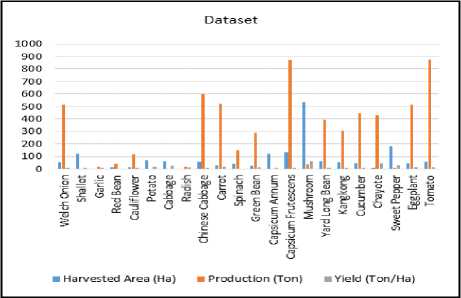
Fig.5. Graphic of Dataset
Fig. 5 shown Dataset of Food Commodity (22 point data) by criteria Harvested Area, Production, and Yield.
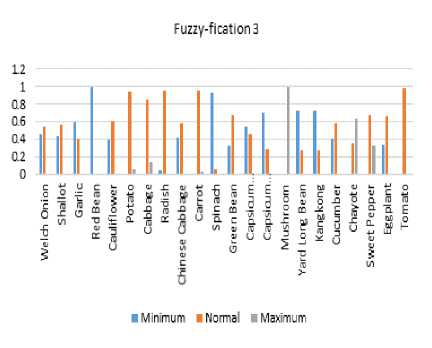
Fig.8. Graphic of Fuzzy-fication 3
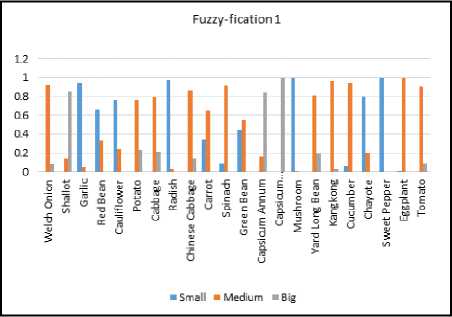
Fig.6. Graphic of Fuzzy-fication 1
Fig. 6 shown output Fuzzy-fication 1 based on input variable fuzzy to membership function. Fuzzy-fication 1 using Fuzzy Query: Small, Medium, and Big.
Fig. 8 shown output Fuzzy-fication 3 based on input variable fuzzy to membership function. Fuzzy-fication 3 using Fuzzy Query: Minimum, Normal, and Maximum.
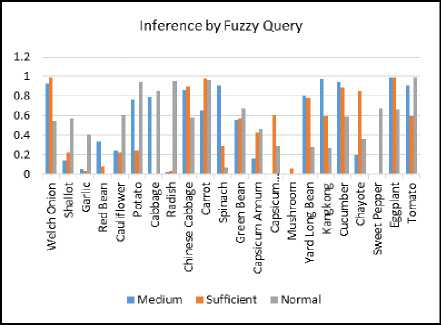
Fig.9. Graphic of Inference by Fuzzy Query
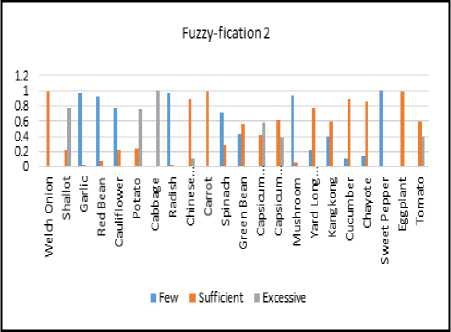
Fig.7. Graphic of Fuzzy-fication 2
Fig. 9 shown Inference using Fuzzy Query: Medium, Sufficient, and Normal.
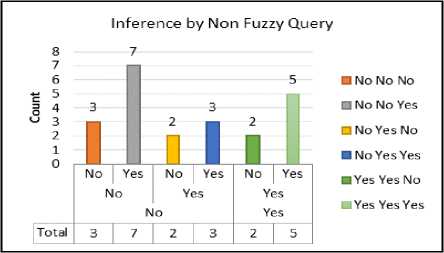
Fig.10. Graphic of Inference by Non Fuzzy Query
Fig. 7 shown output Fuzzy-fication 2 based on input variable fuzzy to membership function. Fuzzy-fication 2 using Fuzzy Query: Few, Sufficient, and Excessive.
Fig. 10 shown Inference using Non Fuzzy Query: Export Commodities, Plant Harvested Several Times, and Fresh Fruit.
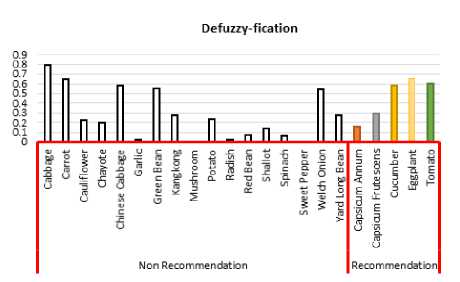
Fig.11. Graphic of Defuzzy-fication
Fig. 11 shown Defuzzy-fication using Fire Strength based on minimum value as output recommendation.
Target

Fire Strength
Fig.12. Graphic of Target
Fig. 12 shown Target based on category by Yes All Output with 5 food commodity as target of priority.
-
V. Conclusion
Main process in this application is Fuzzy-fication, Inference, and Defuzzy-fication based on Fuzzy Logic using Tahani model. Tahani model using Query (Fuzzy Query and Non Fuzzy Query). Input Membership Function based on crisp value of Dataset by using variable fuzzy. Output is target (main priority in scalability and availability) based on value of Fire Strength. Target based on Fire Strength with minimum value, merge and sorting form result of Fuzzy Query and Non-Fuzzy Query. Target is eggplant (0.6587), tomato (0.6023), cucumber (0.5865), capsicum frutescens (0.2901), and capsicum annum (0.1581). Target is recommendation for main priority of national policy on food commodity. Future work, fuzzy logic is by using Mamdani Model, Sugeno Model and Tsukamoto Model on food commodity.
Список литературы Fuzzy Logic using Tahani Model on Food Commodity
- BPS Statistics Indonesia, "Statistics of seasonal vegetable and fruit plants", Sub-directorate of Holticulture Statistics, pp. 1-114, 2015.
- A. Amini and N. Nikraz, "Proposing two defuzzification methods based on output fuzzy set weights", International Journal of Intelligent System and Applications, MECS Publisher, vol. 8, no. 2, pp. 1-12, 2016.
- Z. Hu, Y. V. Bodyanskiy, O. K. Tyshchenko, and V. O. Samitova, "Fuzzy clustering data given on the ordinal scale based on membership and likelihood function sharing", International Journal of Intelligent System and Applications, MECS Publisher, vol. 9, no. 2, pp. 1-9, 2017.
- G. Singh, P. Kunai and D. Goyal, "A review fuzzy logic and its application", International Journal of Engineering and Technical Research, pp. 61-66, 2014.
- A. Nurlayli, U. Pujianto and F. Alqodri, "Implementing fuzzy tahani model for recommendation locate of apprentice", National Seminar Information System, Indonesia, pp. 501-508, 2015.
- I. Nazir, "Decision support system for selection pc tablet by using fuzzy tahani model", Final Project, Informatics Engineering, UIN SUSKA, pp. 1-96, 2013.
- S.A. Aklani, "Decision support system for the period of study and index student achievement using fuzzy tahani method", Pelangi Journal, vol. 6, no. 2, pp. 126-131, 2014.
- A. Hamsar and Erlin, "Application of dashboard for determine work priority of technicians using fuzzy logic", Journal of Research of Applied Science and Education, vol. 8, iss. 1, pp. 192-202, 2016.
- E. Daniati, "Fuzzy logic of tahani model for optional course recommendation in english village pare kediri", Citec Journal, vol. 3, no. 3, pp. 200-213, 2016.
- R. Helilintar, W.W. Winarno and H.A. Fatta, "Application of simple additive and fuzzy method in decision support system scholarship", Citec Journal, vol. 3, no. 2, pp. 89-101, 2016.
- P.N. Lolita, "The support model for secondhand motorcycle purchase using the fuzzy model database and max-min rule", Thesis of Informatics Engineering, Sanata Dharma University, pp. 1-90, 2016.
- K. Singh, "Fuzzy logic based modified adaptive modulation implementation for performance enhancement in ofdm systems", International Journal of Intelligent System and Applications, MECS Publisher, vol. 8, no. 5, pp. 49-54, 2016.
- I.A. Nasution, "Decision support system for determine laptop selection by using fuzzy tahani", Pelita Informatics of Budi Darma, vol. 6, no. 1, pp. 93-96, 2014.
- K. N. Kumar, C. S. Reddy and N.V. E. S. Murthy, "Fuzzy based xml knowledge retrieval methods in edaphology", International Journal of Intelligent System and Applications, MECS Publisher, vol. 8, no. 8, pp. 55-64, 2016.
- G. Taufiq, "Fuzzy logic tahani to support decision recruitment employee", Proceeding National Seminar Applied Science and Technology, pp. 9-106, 2014.
- A. Garg and R. Rishi, "Querying capability enhancement in database using fuzzy logic", Global Journal of Computer Science and Technology, vol. 12, iss. 6, ver. 1.0, pp. 1-9, 2012.
- Kahar, N. "Decision support system for jamkesda acceptance at jambi city", National Conference Informatics, vol. 1, pp. 215-220, 2013.

